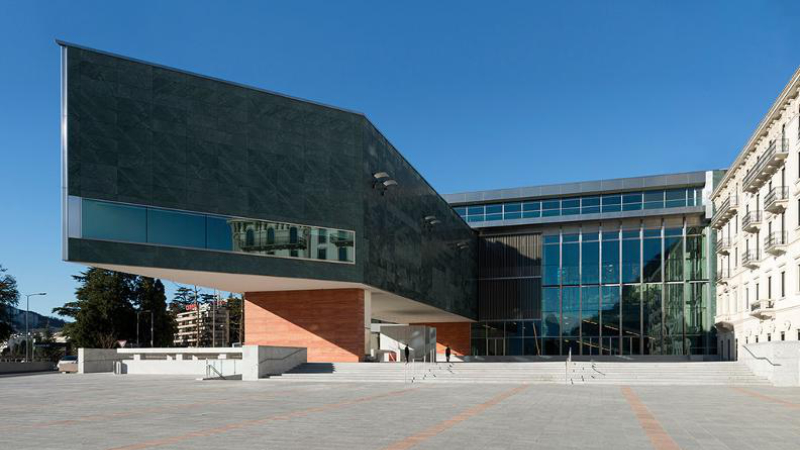March 28, 2023
LuganoMusica
LAC Lugano Arte e Cultura
Lugano, Switzerland
Maurizio Pollini, piano.
Arnold SCHÖNBERG: Drei Klavierstücke, Op. 11
Arnold SCHÖNBERG: Sechs kleine Klavierstücke, Op. 19
FLuigi NONO: …sofferte onde serene…
Frédéric CHOPIN: Mazurka in C minor, Op. 56, No. 3
Frédéric CHOPIN: Barcarolle in F♯ major, Op. 60
Frédéric CHOPIN: Scherzo in B minor, Op. 20, No. 1
Giorgio Koukl | 29 MAR 2023
On Tuesday, March 28, at the new Lugano concert hall called LAC (a nice acronym of Lugano Arte e Cultura), the world-famous Italian pianist Maurizio Pollini played a recital combining a romantical Chopin treat with a 20th-century part, a combination which seems particularly dear to the maestro.
That is not simply an excellent but personal way to spread the knowledge among the concertgoers of not-so-popular fare of Arnold Schönberg, or even less known Luigi Nono. It is far more.
As Mr. Pollini explains in a short video presented recently, his way of choosing scores has something to do with the idea that this particular music will accompany his life for years or maybe decades, so it must be convincing enough not to get boring or obsolete too soon, certainly a respectable concept of choice for somebody not willing to be squeezed into the usual recital program which unfortunately is the standard nowadays.
Luckily, Pollini’s world fame is strong enough to maintain such an attitude together with just another habit: As far as it is known, he is today the only pianist who brings his own Steinway concert piano on every stage when performing and keeps his attentive eye on its conditions for two days together with his personal piano tuner to have the most suitable working conditions available. A luxury we have known from the past (Michelangeli, Horowitz), but today for obvious financial reasons quite impossible.
Pollini was in contact with the most influential composers of the so-called Darmstadt school during the seventies. Since then, he has regularly played scores dedicated to him by such big names as Pierre Boulez, Luigi Nono, and Karlheinz Stockhausen.
The recital opened with Arnold Schönberg’s Three Pieces, Op.11, an excellent example of the first atonal attempts of the Austrian composer. Clearly declared as a painting “without architecture.. an ever-changing, unbroken succession of colors, rhythms, and moods,” it has strong ties with the work of the painter Kandinsky, which whom Schönberg was in contact.

LAC Lugano Arte e Cultura is an elegant building and the heart of cultural activity in the city of Lugano, in the canton of Ticino, Switzerland.
Pollini is extremely attentive to every single detail, creating a landscape of nearly translucent and rarefied beauty. This score is still not in dodecaphonic style but is pretty difficult to follow. In the rendering of Maurizio Pollini, magic happens, and everybody in the concert hall follows with enthusiasm his gestures and minimalistic approach.
As a logical continuation, Op. 19, called Six Small Piano Pieces, followed. Here the music is even more rarefied. Schönberg insisted even on the necessity to maintain adequate long breaks between the miniatures, declaring, “My music is not something for people who have no time.” Well, Pollini has his own style, which contradicts the composer’s indications in some ways.
When he rushes onto the stage, he starts playing immediately, sometimes even before being properly seated. But this “trademark “in no way disturbs the deep concentration with which the great Italian maestro delivers every tiny detail.
The first part of the recital concluded with a work of Luigi Nono (1924-1990) entitled “…sofferte onde serene…” ( freely translated into English: “suffered peaceful waves”), a 15-minute piece written for Maurizio Pollini where a tape and a pianist interact. This music had its followers in a Milan cultural scene of the seventies, fully immersed in the “progressive and leftist” atmosphere, where political program was at times more important than the musical content. Today the big risk for this music would be to appear “oldish,” too much linked to the excesses of the seventies.
The “magnetic tape,” as it is defined, was realized in the Italian radio studios in 1974 and is serviced by a technician sitting in the first row of the hall, who gets his instructions from the pianist with short and energetic gestures. There are seven takes with which to interact in all, and sometimes the dynamic interplay with the piano can also be an issue. In this performance, the strange sonic world, from time to time of an unsettling quality, was fully convincing and a real surprise.
After all this suffering and intellectually challenging first part, the public was treated to a nice second-half opener by Chopin: a C minor Mazurka. Pollini chose a very slow tempo and seemed a hint less convincing than in his preferred 20th-century world.
The Op. 60 Barcarolle followed. Keeping in mind the reference which, despite its age, still holds the position of best rendering ever, that of Arthur Rubinstein, this was a completely different formulation, which preferred a grace and easiness of gesture over a purely muscular approach.
The recital ended with what was supposed to be a real firework, the Scherzo, Op. 20 No. 1. Written in 1833, it still sometimes bears the title “Le banquet infernal” and is an absolute nightmare for every pianist.
All this Chopin music was recorded many decades ago by Mr. Pollini for the Deutsche Grammophon label. Today, Pollini privileges a more soft and relaxed approach, which has its grace but sometimes simply lacks power.
Such infrequent, rare moments when the public can get an opportunity to listen to the absolute legends of the piano world are of the greatest value that organizers of the LuganoMusica festival can give to the city and attract the public from very far away. Let’s hope this line can be pursued in the future, too. ■
EXTERNAL LINKS:
- Maurizio Pollini: deutschegrammophon.com/en/artists/mauriziopollini/biography
- LuganoMusica: luganomusica.ch
- LAC Lugano Arte e Cultura: luganolac.ch

Read more by Giorgio Koukl.







.png)